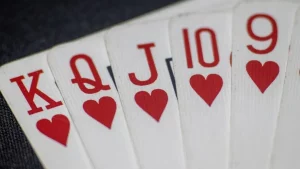What is Horse in Poker
HORSE poker stands out for its diversity and variety of games as opposed to the simple game of poker. HORSE is a combination of five different types of poker, each requiring an understanding of the nuances of the game. This variant serves as the ultimate test of a poker player’s skill by intertwining the two:
- H – Hold’em
- O – Omaha High/Lo
- R – Razz
- S – Seven Card Stud
- E – Eight or Better (High/Lo Stud).
Here I’ll cover everything you need to know about HORSE poker, from the basic rules governing each of its parts to strategies that can elevate your game. Emphasizing the importance of HORSE in the competitive poker landscape, the $50,000 HORSE Championship at the World Series of Poker (WSOP) is the pinnacle of achievement and recognition in the community. This prestigious event not only demonstrates the high level of skill required to participate in HORSE poker, but also emphasizes its importance and uniqueness among all poker games.
HORSE poker is inextricably linked to the legend of Chip Reese, winner of the first $50,000 HORSE Championship. Reese’s triumph cemented his status as one of poker’s greatest minds, demonstrating unprecedented skill in all formats included in HORSE. His success in this demanding variant serves as an inspiration to players striving to reach the zenith of poker prowess.
How to Play Horse Poker
The game goes through an alternation of poker varieties, starting with Texas Hold’em, then Omaha High/Lo, Razz, Seven Card Stud and ending with High/Lo Stud (Eight or better). After completing a round with High/Lo Stud, a new round with Texas Hold’em begins, providing a dynamic and varied poker experience.

The initial stages of HORSE poker begin with Texas Hold’em and Omaha High/Lo, which are flop games. This means that after the first round of betting, a set of common cards are laid face up in the center of the table for all players to use to compose their best hand. The betting dynamics of these games lay the foundation for the variety of skills needed in HORSE poker.
After the flop games, the format moves on to three Stud games: Razz, Seven Card Stud, and Stud Hi/Lo (Eight or Better). Unlike flop games, these are table games in which each player receives a different set of cards, some of which are face up and some of which are face down. This transition requires players to make significant adjustments to their strategy as they move from being dealt common cards to playing individual hands with partial information visible to their opponents.
An interesting aspect of HORSE poker is the division of games based on the distribution of the pot. Specifically, Omaha High/Lo and Stud High/Lo (Eight or Better) are games with a split pot. In these variants, the pot is split between the best high hand (High) and the best qualifying low hand (Low), if any. This dual purpose creates an additional level of strategic depth as players must decide whether they should play a High hand, a Low hand, or try to scoop the entire pot with the best High and Low hands.
Best Combinations in HORSE Poker
In HORSE poker, where players must navigate a large number of poker varieties, understanding the hand rankings of each game is paramount. In each segment of HORSE poker, the best possible hand comes to the forefront and is the foundation for players looking to improve their poker skills and move to a higher level of play.

Starting with Texas Hold’em and Omaha, the best hand combination is the royal flush. This hand, which is a sequence of five cards of the same suit from 10 to Ace and is unrivaled. The tantalizing possibility of a royal flush represents the best poker hand combination of all possible hands. The search for this rare hand adds to the excitement of the game.
Moving on to Razz, the game changes as the rules of the game change completely and requires a more detailed understanding of all the rules and features of each game. Here the best hand is considered to be a straight “wheel” – a sequence of Aces to Fives.
The understanding of the lowest hand extends to the “low” segments of Omaha high-low and herd high-low, where the straight wheel also reigns supreme. In these split-pot variants, the ability to assemble the lowest possible hand often becomes as important as making the highest hand. Balancing this dual goal requires an understanding of the value of hands and the ability to anticipate future actions in play to chase a high or low pot – or, in the most favorable scenarios, both.
Texas Hold’em
Texas Hold’em is a variation of poker that has become one of the most popular games around the world and is known for its complexity and fascination. The essence of Texas Hold’em is a combination of common and personal cards, with players trying to make the best five-card poker hand from the available options. This combination of common and personal cards sets Texas Hold’em apart from other poker games.

The game begins with each player being dealt two personal cards, called hole cards, that belong to them alone. After the first deal, several rounds of betting and revealing the common cards – flop (three cards), turn (one card) and river (one card) – take place sequentially. Players must make decisions based on the strength of their hole cards combined with the common cards laid out on the table. The goal is to assemble the strongest possible five-card hand or to induce opponents to discard cards, thereby securing the pot without the need for a showdown.
Betting rounds are an integral part of Texas Hold’em, starting with the preflop round, which occurs immediately after players receive their hole cards. Subsequent betting rounds follow the dealing of the flop, turn and river cards. Critical to the strategy of the game is the ability to assess the potential strength of your hand, predict your opponents’ hands and decide whether to bet, call, raise or fold at any given time.
Position plays a crucial role in Texas Hold’em, influencing players’ strategy depending on their relative betting order. The dealer’s position, which changes clockwise after each hand, determines the order of play, and some positions require forced bets known as the small and big blind to start the game. This positional play adds another layer of strategy, as players must adjust their approach based on their position relative to the dealer and blinds.
The game of Texas Hold’em culminates in a showdown when two or more players remain after the last round of betting. Players reveal their hole cards, and the best five-card hand, conforming to traditional poker hand ranking, wins the pot.
Omaha
Omaha poker, a variant of the traditional game, features a unique combination of rules and strategic depth that makes it a favorite among poker enthusiasts. Distinguished primarily by the number of hole cards dealt to each player and the requirements for hand formation, Omaha brings other rules to poker that are different from those of other forms of poker.

The game begins with each player being dealt four personal hole cards, which is quite different from Texas Hold’em where only two hole cards are dealt. Increasing the number of hole cards drastically changes the dynamics of the game, offering a wider range of possible hand combinations and thus increasing the level of strategic play.
One of the basic rules of Omaha poker, which defines its essence, is the requirement for players to use exactly two of their hole cards in combination with exactly three of their five community cards to form their best possible five-card hand. This requirement is key and represents a major feature of the game compared to other varieties of poker. It requires careful selection of hole cards, which can lead to more calculated and subtle strategies as the hand develops.
After the initial deal of hole cards, the game follows a sequence similar to Texas Hold’em, with a series of betting rounds and community card reveals. These include the flop (first three community cards), then the turn (fourth community card) and finally the river (fifth community card). Each of these stages is interspersed with betting rounds, allowing players to assess the strength of their hands and adjust their strategy accordingly.
Position and order of play are crucial in Omaha, as they affect decision making and the course of the game. Betting starts with the player to the left of the dealer and proceeds clockwise. The game uses forced bets, known as blinds, to initiate action and create a pot worth fighting for. Players must navigate these positional dynamics, as well as the complexities created by four hole cards, to optimize their play.
Razz
Razz stands out from other poker games primarily because of its purpose and method of ranking hands. Unlike most poker games where the highest hand wins, Razz turns this tradition upside down by awarding the victory to the player with the lowest hand. The essence of Razz is to compile the best possible low hand from the seven cards dealt throughout the hand. The game is played with a standard 52-card deck and can be played with up to eight players. Razz is a Stud game, meaning that there are no shared cards like in Texas Hold’em or Omaha. Instead, each player is dealt an individual hand, some cards face down (hidden from other players) and some face up (visible to all).

The game of Razz begins with each player being dealt three cards: two hidden hole cards and one exposed card. The player with the highest visible card starts the betting round, which is a feature because in this context “highest” means least favorable. The action continues clockwise around the table. Unlike other varieties of poker, where a high card is an advantage, high cards are undesirable in Razz.
Subsequent rounds, called “streets”, proceed as follows: each player receives an additional card face up (4th street, 5th street, 6th street), followed by a betting round, culminating in 7th street, where the last card is dealt face down. Each betting round offers players the option to bet, check, raise, or fold depending on the strength (or weakness, in the context of Razz) of their developing hand.
Hand rankings in Razz are the opposite of what exists in most poker games. The best possible hand is A-2-3-4-5, known as a “wheel”, and flushes and straights are not counted for hand ranking purposes. This means that, unlike other variants, such combinations are not counted by the player when determining the lowest hand. Thus, understanding which starting hands have the best potential to develop into a strong low hand is the key to success in Razz.
Seven Card Stud
Seven Card Stud, a classic variant of poker, holds a special place in poker games due to its distinctive structure and the unique strategies it requires. Unlike popular common-card games such as Texas Hold’em and Omaha, Seven Card Stud relies solely on cards that are dealt to each player individually, and there are no common cards. This format of play encourages sophisticated strategy, keen observation, and careful study of hands over several rounds of betting.

The essence of seven-card stud is to compose the best possible five-card hand from the seven cards a player is dealt. The game begins with each player receiving three cards: two face-down cards, known as hole cards, and one face-up card, called the door card. This initial deal lays the foundation for the strategic depth that seven-card stud is known for, as players must make decisions based on a combination of private information and their opponents’ visible cards.
After the first deal, each player remaining in the hand is dealt four more cards in succession. These cards are called “streets”: the fourth, fifth, and sixth cards are dealt face up, while the seventh and final card, known as the “river,” is dealt face down. After each card is dealt, a betting round begins, giving players plenty of opportunities to assess their hand position and adjust their strategy accordingly.
One of the most important aspects of seven-card stud is the role of visible cards in influencing gameplay. Players must pay close attention to their opponents’ cards, as they provide crucial clues to the potential strength of each player’s hand. This element of observation requires a high level of skill and memory, as successful players will keep track of not only the cards in play, but also those that have been discarded, thereby gaining information about remaining cards that may improve their hands or those of their opponents.
Seven-card stud does not utilize blinds like other varieties of poker. Instead, the game uses an ante, a forced bet that all players make to start the pot, and a bridge-in, a forced bet made by the player with the lowest card after the first hand. This structure emphasizes the importance of individual card strength from the start, setting the tone for a highly competitive game.
High-Low Eight or Better
High-Low Eight or Better, often abbreviated as Hi-Lo 8, is a type of poker that offers a double pot system that greatly diversifies traditional poker gameplay. This game is characterized by a unique objective: the pot is split between the highest and lowest qualifying hands, with the “eight or better” rule applied to the low hand. This division of the pot creates a strategic complexity that requires players to deftly navigate the simultaneous accomplishment of two different goals.
The essence of Hi-Lo 8 is a split pot format where players are incentivized to draft both high and low hands according to the type of poker they are playing, such as Omaha or Seven Card Stud. The “eight or better” condition means that for a hand to be considered low, it must consist of five cards of different ranks, all eight or lower, with no pairs. The best possible low hand is A-2-3-4-4-5, often referred to as a “wheel.” If no hand qualifies as a low hand, the best high hand gets the entire pot, which is in line with traditional poker rankings.
A key feature of Hi-Lo 8 compared to other poker games is the balancing of players’ desire for a big pot, a small pot, or both. This dual goal promotes a more versatile approach to hand selection and playing style, as players must consider the possibility that their hands could win either half the pot or, ideally, “scoop” the entire pot with both the best high and low hands.
The game begins with each player being dealt cards, the specifics of which depend on whether Omaha or Stud is the base game for the Hi-Lo 8 variant. In the Omaha Hi-Lo game, players are dealt four hole cards and must use exactly two of them in combination with three of the five community cards to make up their best high and low hands. In a seven-card Hi-Lo pack, players are dealt seven cards throughout the hand, with cards dealt both face up and face down, and must choose the best combination of five cards to make up their best high and low hands.
Betting rounds in Hi-Lo 8 follow the structure of the base game: at each stage, you can bet, raise, call or fold. Players’ strategic considerations include not only the strength of their current hands, but also the potential to improve to a qualifying low hand, the likelihood of taking the pot, and their opponents’ betting actions.
HORSE Poker Strategy
Playing HORSE poker effectively requires not only knowledge of its components, but also skill and a good knowledge of all five poker varieties it includes. Below I have written strategies to follow in order to improve your HORSE poker game:
Understanding the rules of each phase
HORSE poker alternates between Hold’em, Omaha Hi-Low, Razz, Seven Card Stud and Seven Card Stud Eight or better. Mastery of HORSE begins with a thorough understanding of the rules and nuances of each game. This basic knowledge is essential, as it allows for strategic flexibility and informed decision making in a variety of games.
Bankroll Management
Given the variety of games within HORSE, bankroll management becomes a challenge. Each variant may require a different approach and level of risk, which will affect the allocation of your funds. Effective bankroll management provides longevity and resilience, allowing you to withstand the volatility inherent in moving from one game to another.
Adaptability and flexibility
The essence of HORSE poker is its diversity, so adaptability is key. Success in HORSE requires the ability to adjust your strategy on the fly, adapting your playing style to the demands of the current game. This flexibility extends to adapting to the dynamics of the table and the specific challenges each variation presents.
Ability to read your opponents
Observation skills are paramount in HORSE poker. Each variant offers unique opportunities to gain insight into your opponents’ tendencies and possible hold’ems. Developing a keen sense of observation enhances your ability to anticipate and counter your opponents’ strategies, giving you a competitive advantage in all phases of HORSE.
Starting Hand Strategy
The value of starting hands varies significantly from one HORSE game to the next. A thorough understanding of which hands to play and how aggressively to play them is crucial. For example, the strategic approach to starting hands in Hold’em differs dramatically from that in Razz. Recognizing and using strong starting hands that are appropriate for each stage of the game is the cornerstone of a successful HORSE strategy.
Post-Game Management
Skillful management after the flop, fourth street, or a round of post-raise betting can make a significant difference in your results. Effective hand management involves not only playing to the strengths of your hand, but also managing your pot size wisely to protect your bankroll and maximize your potential winnings.
Tight-aggressive style
In HORSE poker, a tit-for-tat aggressive style of play is often advocated. This approach involves being selective about the hands you choose to play and an aggressive betting strategy when you enter the pot. This style can be particularly effective at utilizing the natural ebb and flow of the game, making you a formidable opponent.
Psychology of the game
The psychological component of HORSE poker cannot be underestimated. The ability to project confidence, mislead your opponents, or pick up on subtle signals can dramatically affect the game. Mastering psychological tactics, from bluffing to bluff detection, and understanding the mental game are key to successfully navigating the challenging stages of HORSE poker.
Conclusion
The appeal of HORSE poker lies in its variety and the requirement to understand multiple poker disciplines. Skill in each individual component of the game is paramount, as moving from one variation to another requires not only a change in strategy, but also a change in mindset to accommodate aspects of the strategy and rules of each game.
However, it is this complexity and the need to possess an extensive skill set in the various poker games that leads me to caution beginners intrigued by HORSE poker. While undoubtedly exciting, HORSE poker is not a game to be taken lightly, especially by those who are still learning the basics of poker. The requirement to excel in five different varieties can be daunting, and success in HORSE poker depends on significant experience in each of these games.
For those new to the world of poker, I highly recommend that you take the time to learn and master each of the individual games that make up HORSE poker before attempting to master this format. Establishing a foundation, understanding the nuances of each game, and honing strategies in these individual contexts are critical steps towards becoming a competent HORSE poker player.

